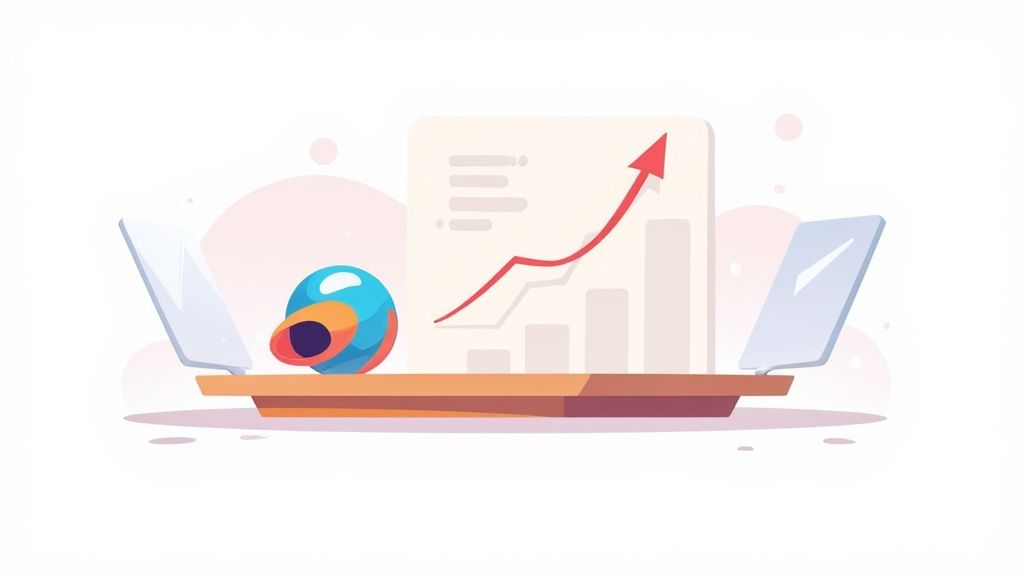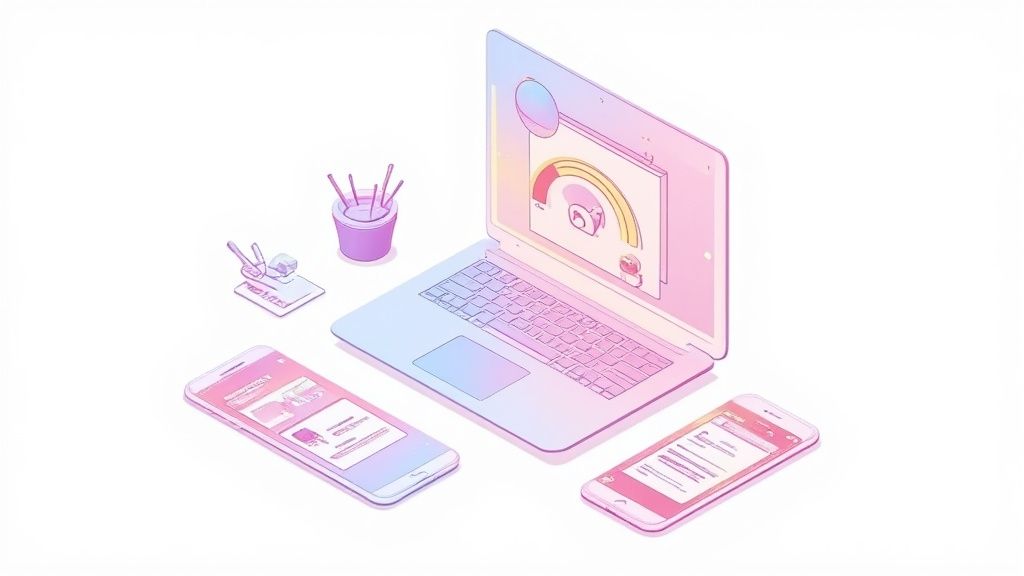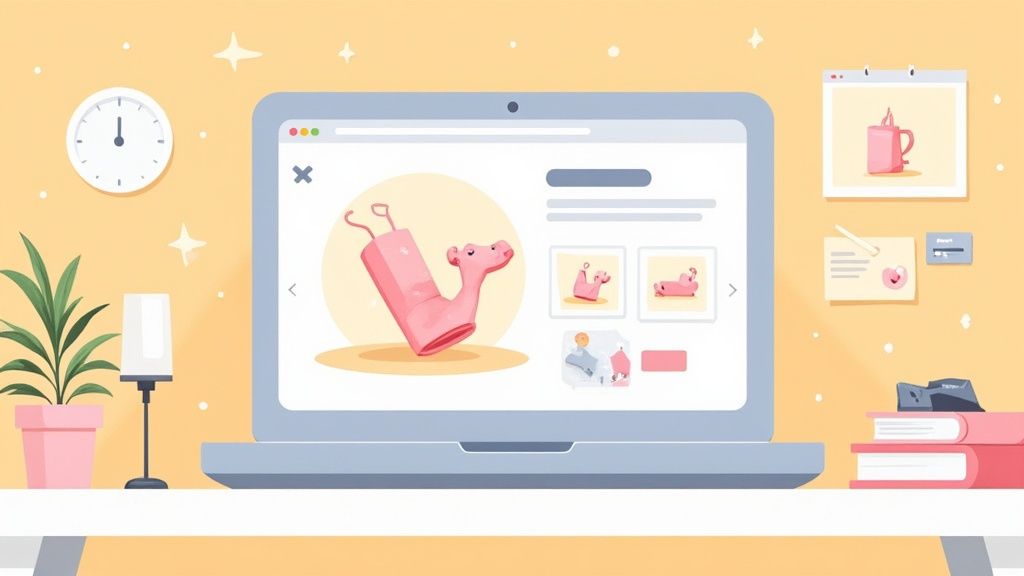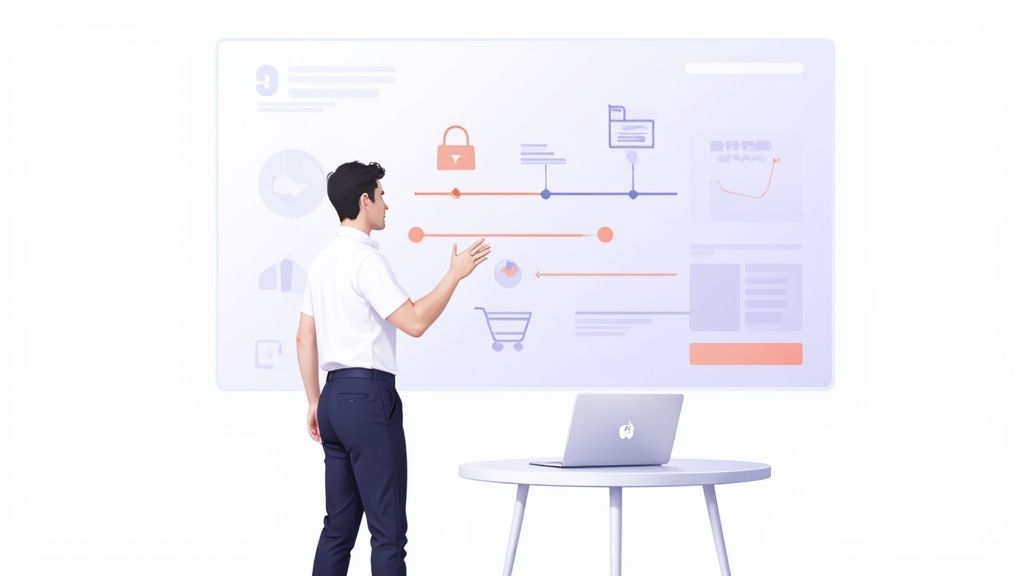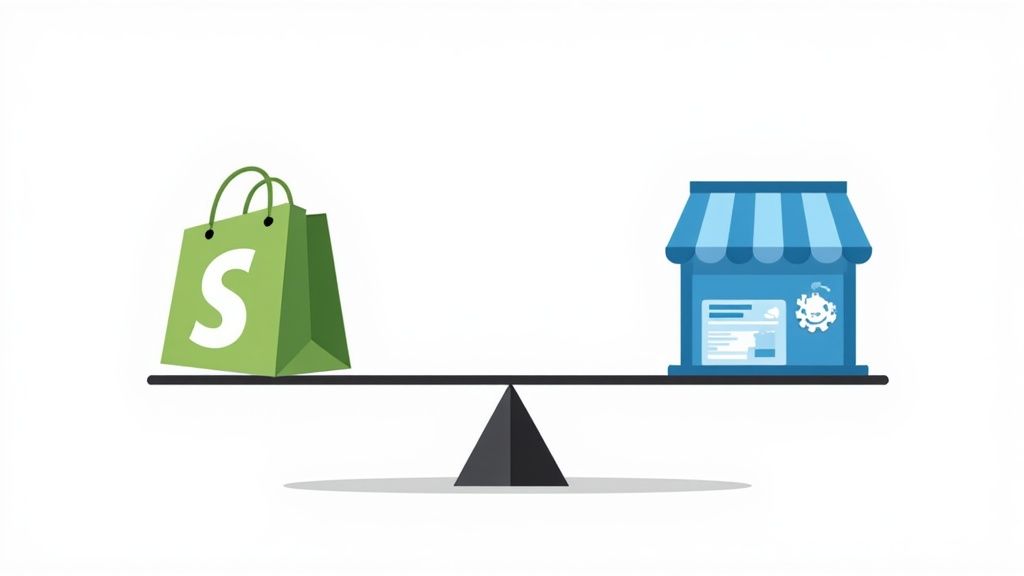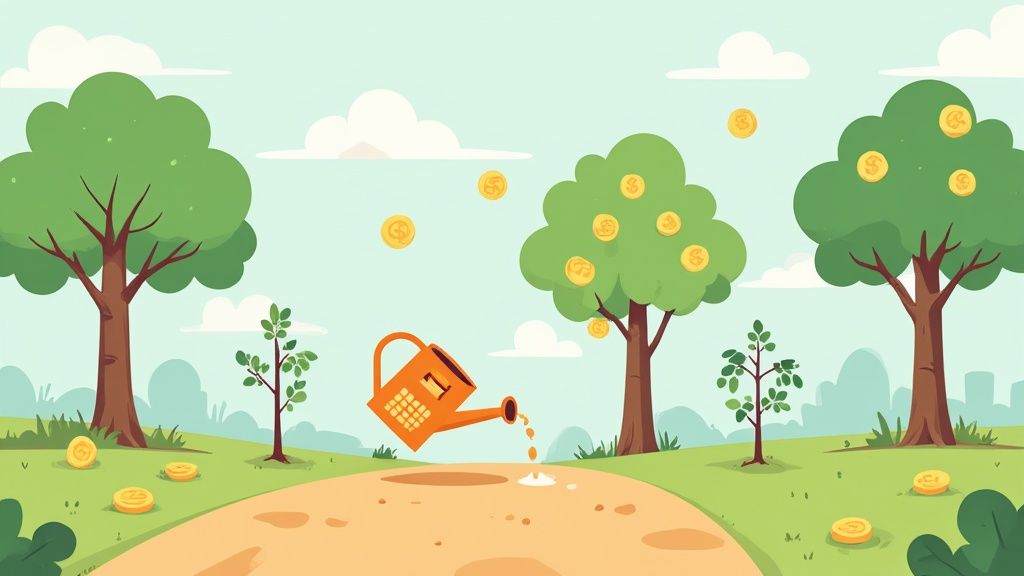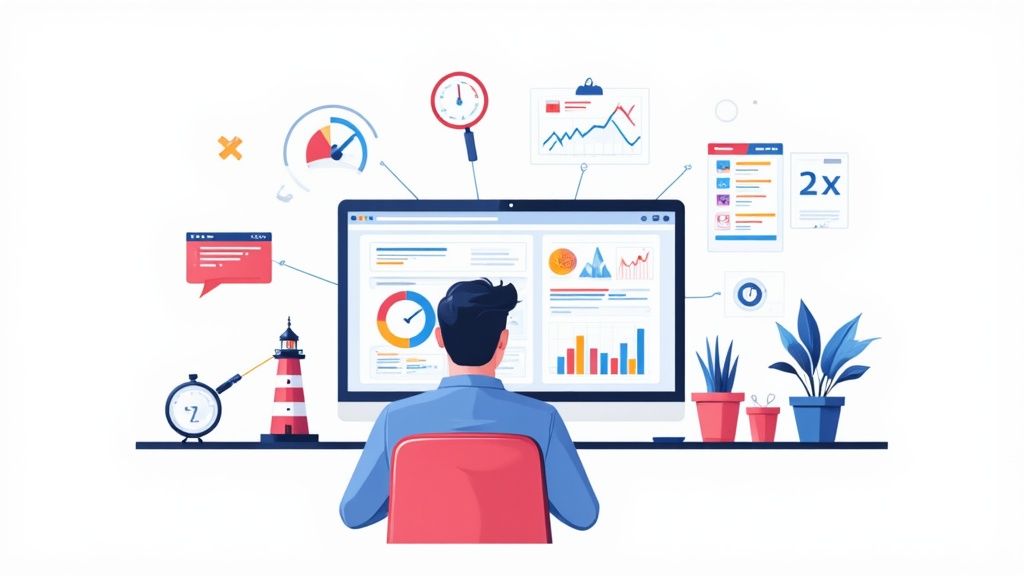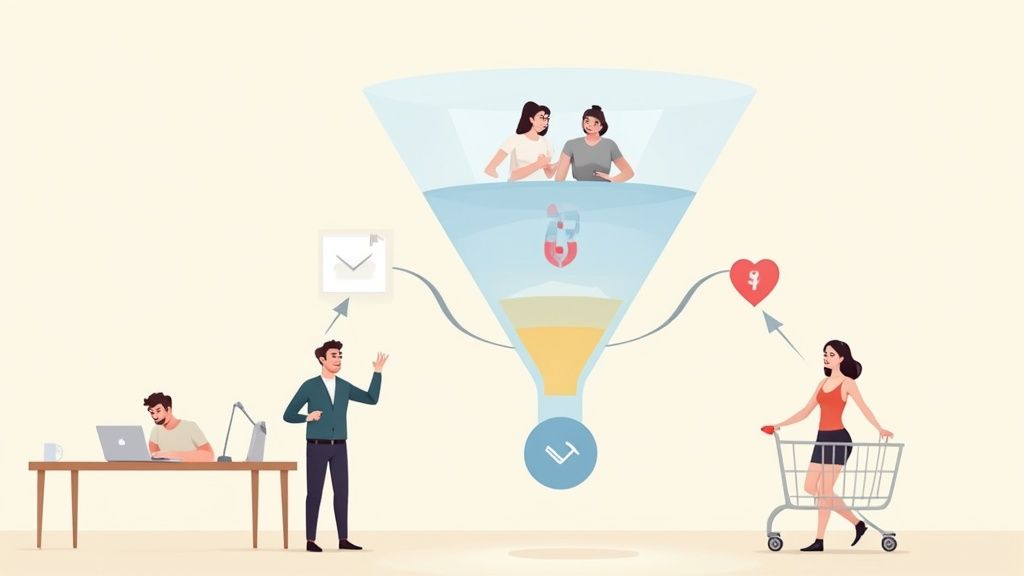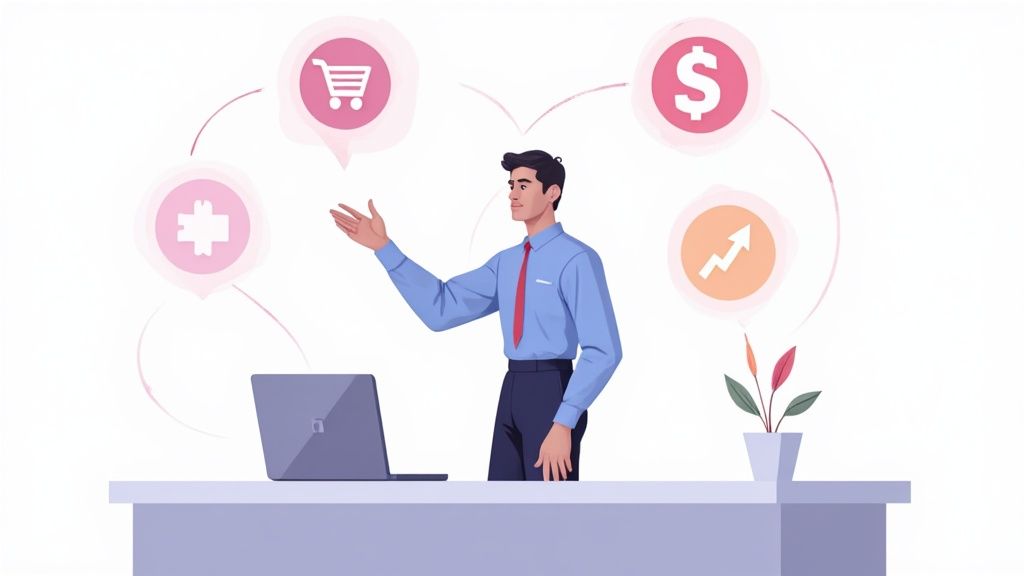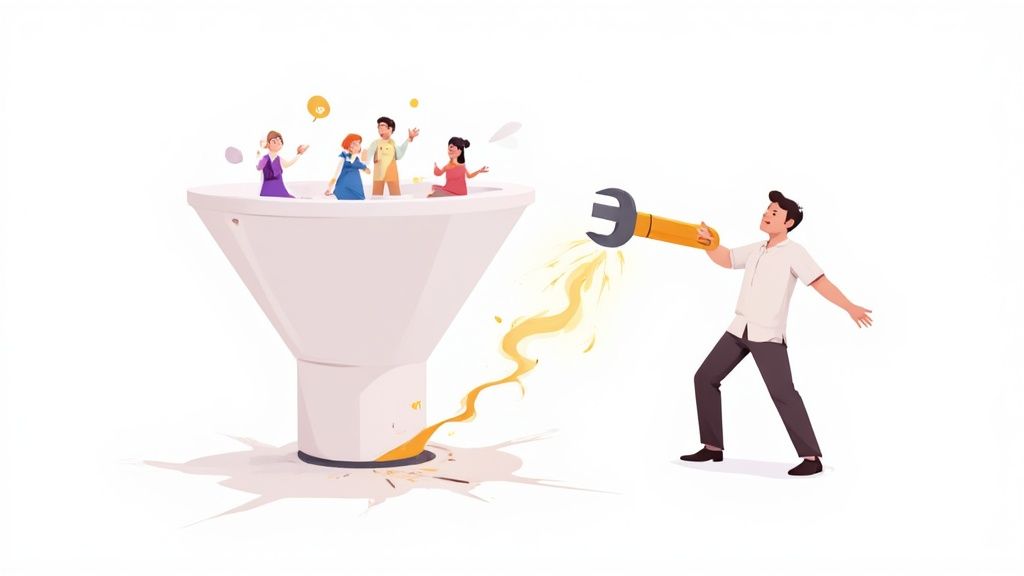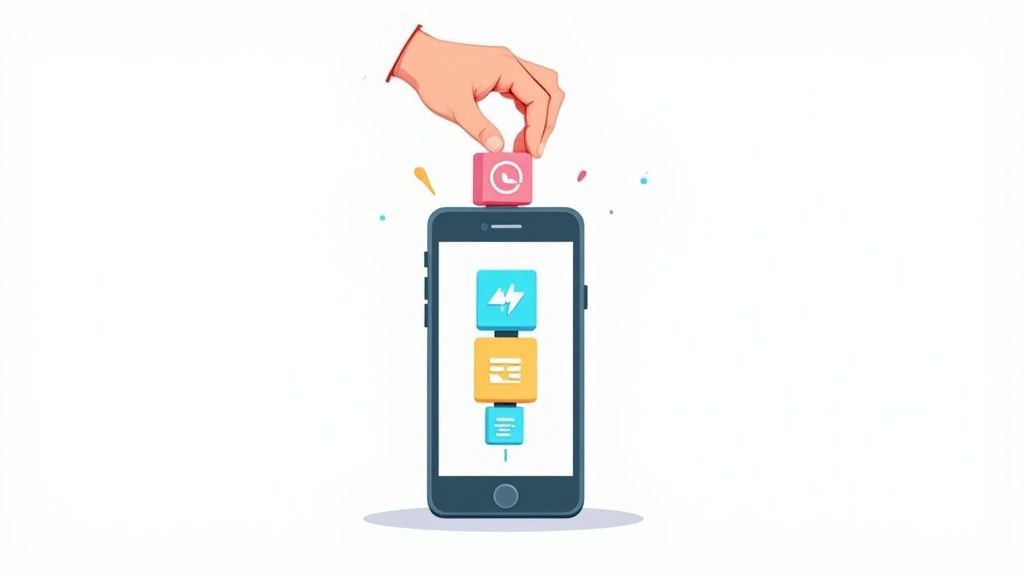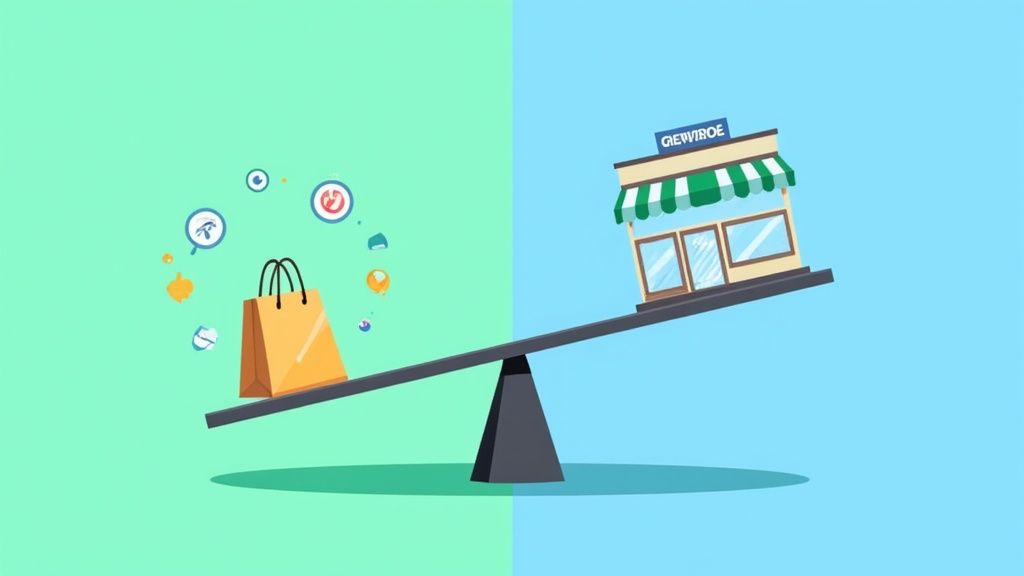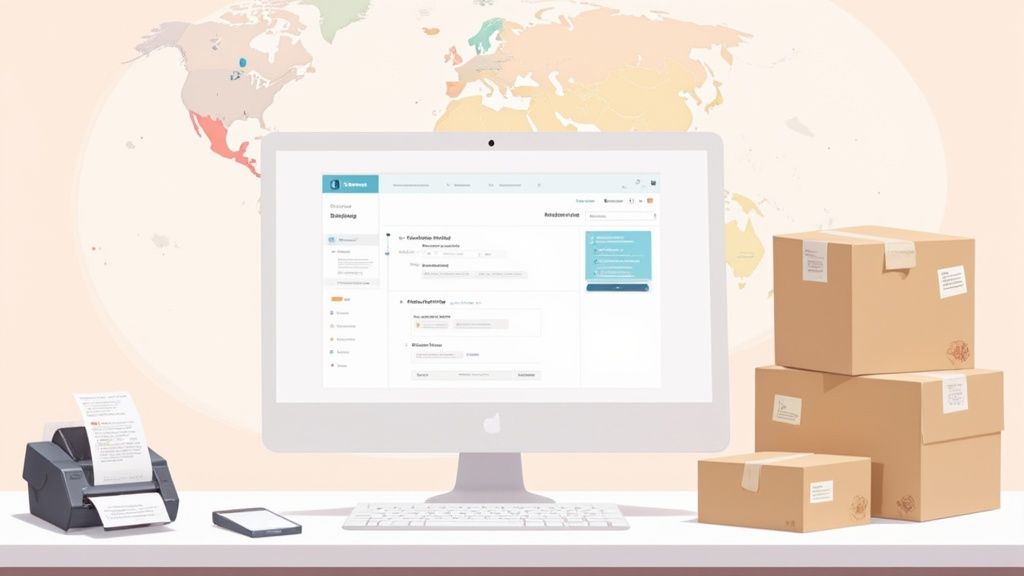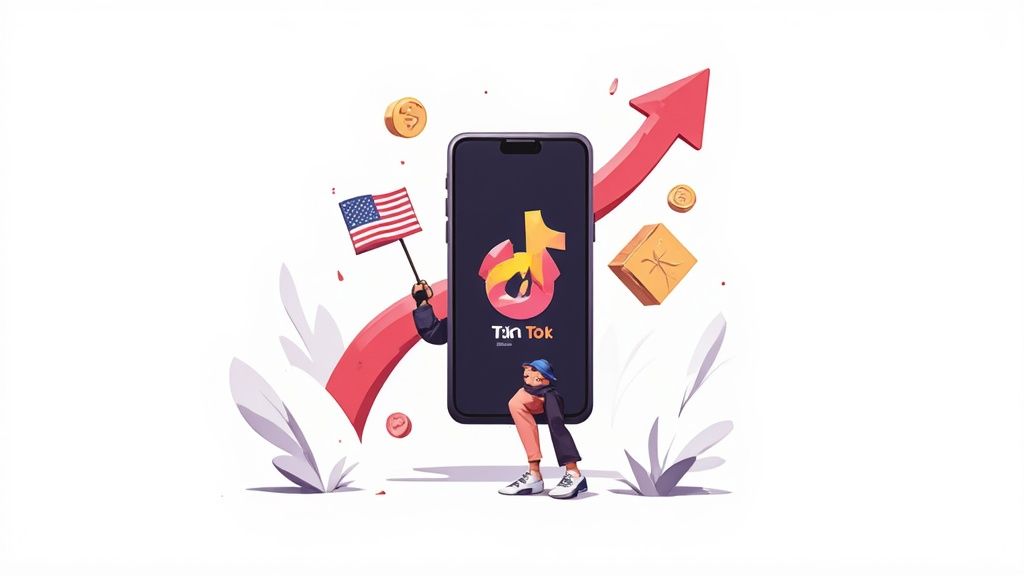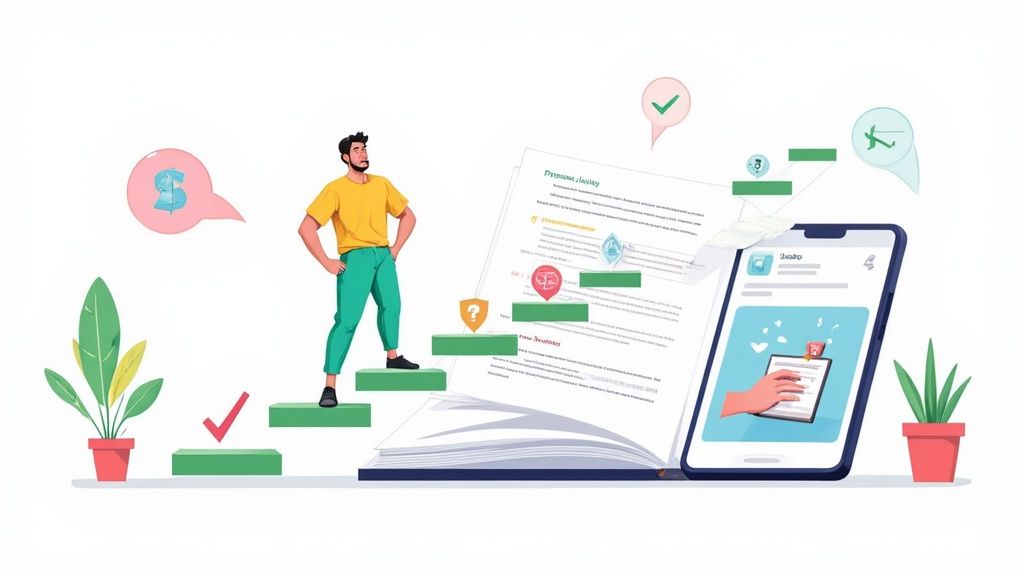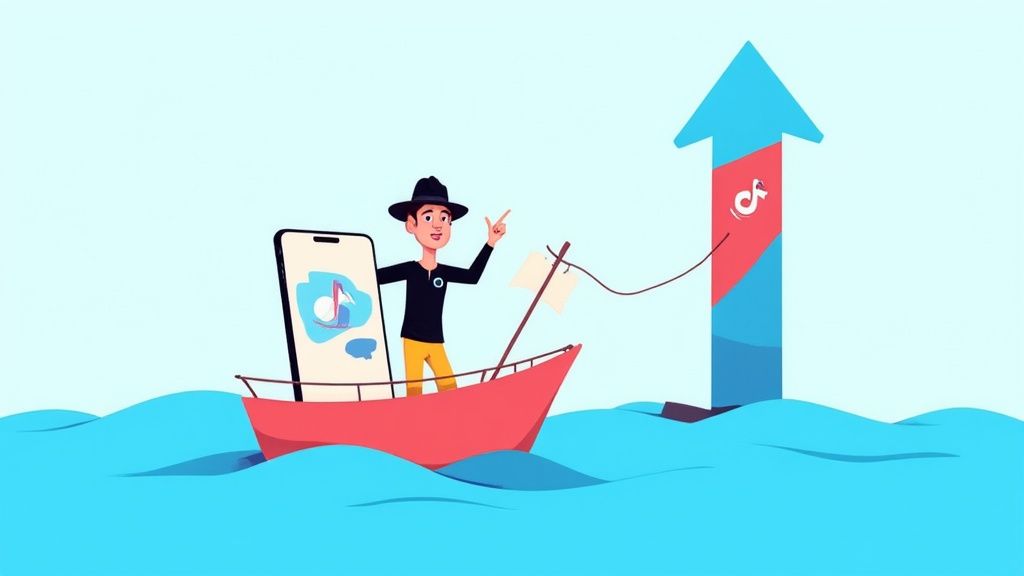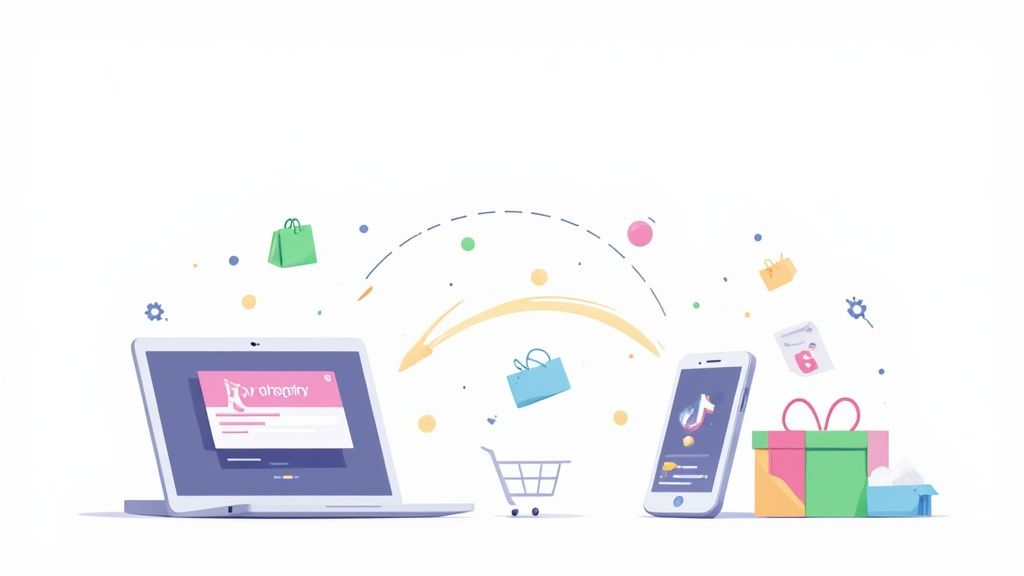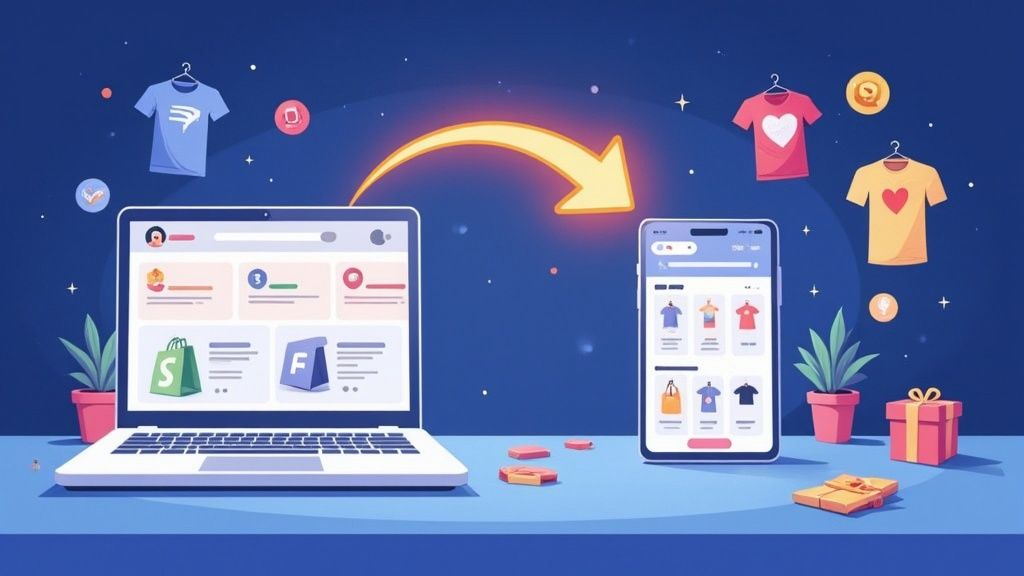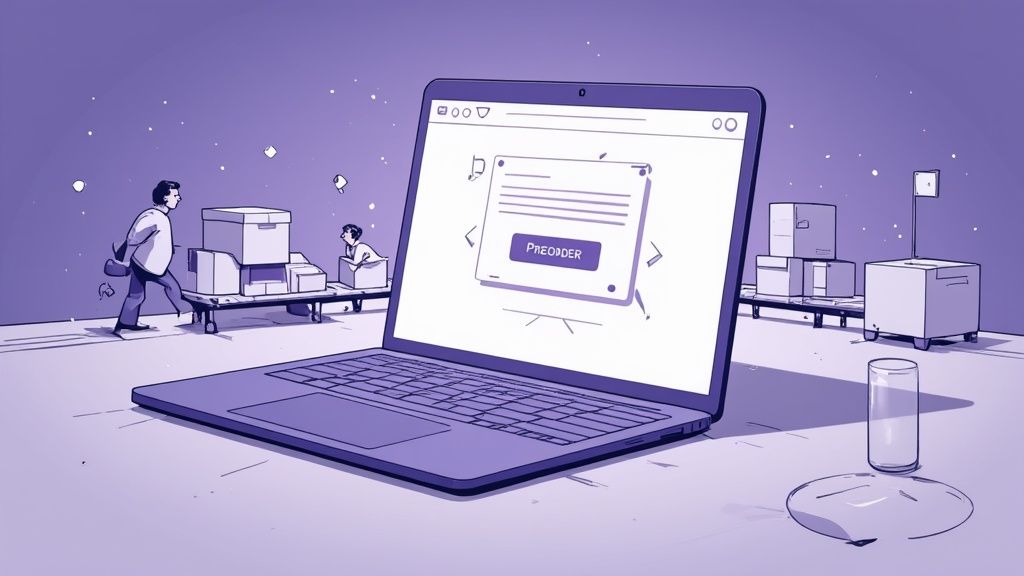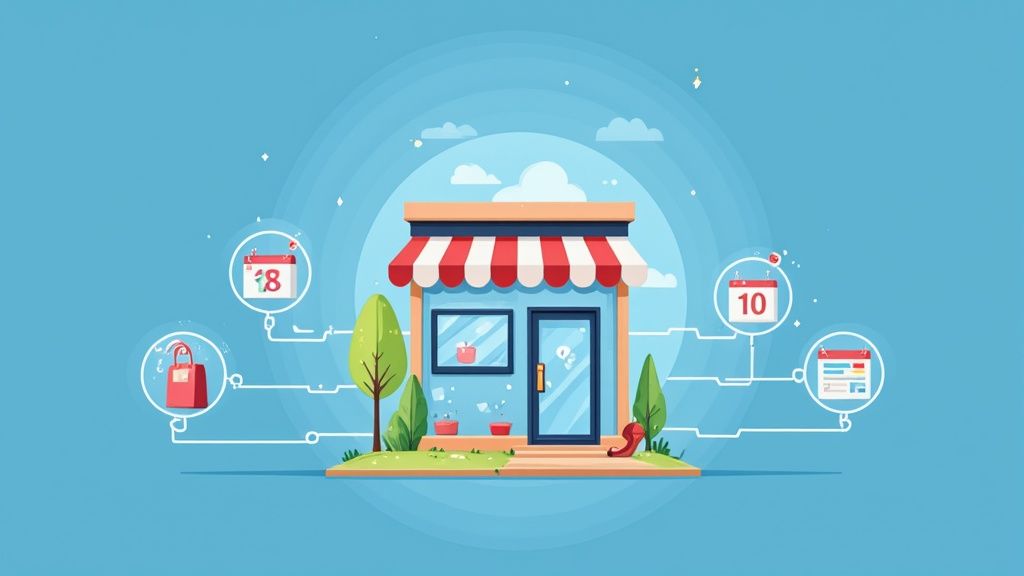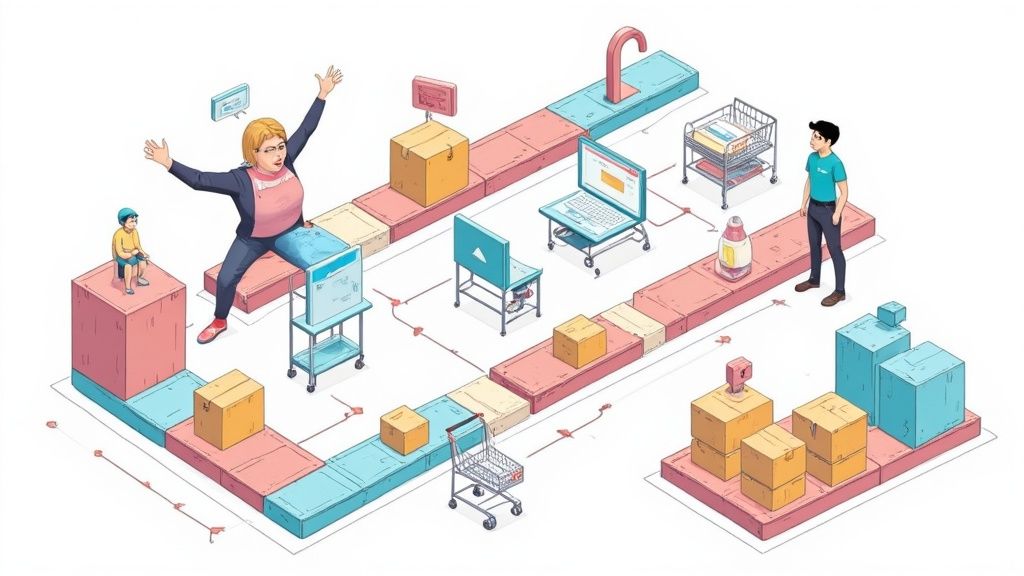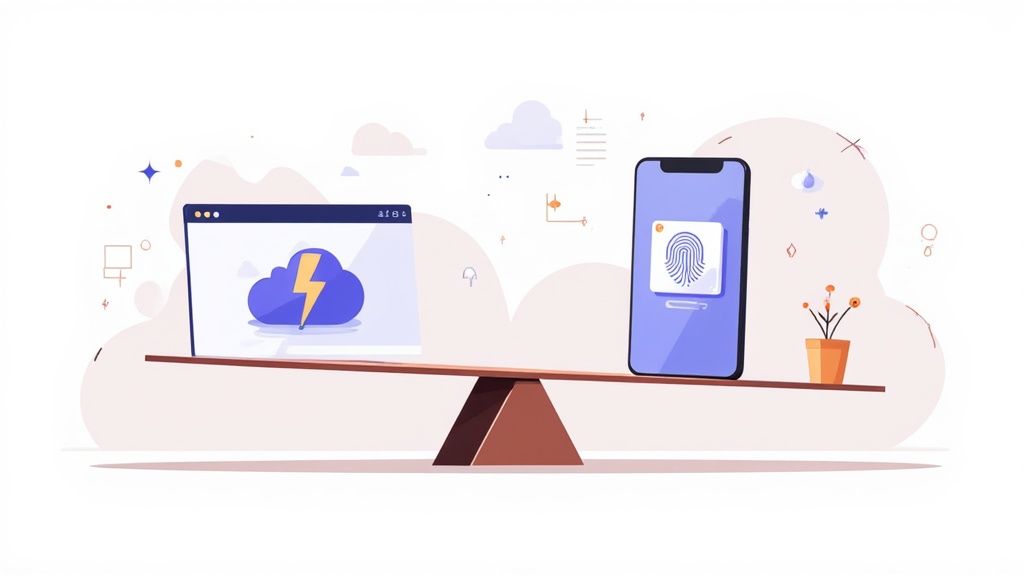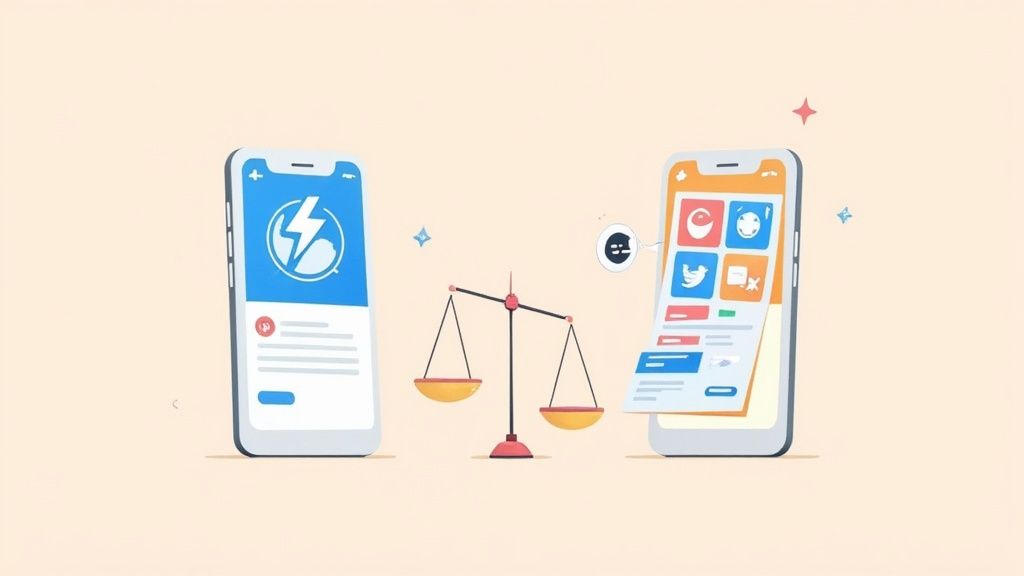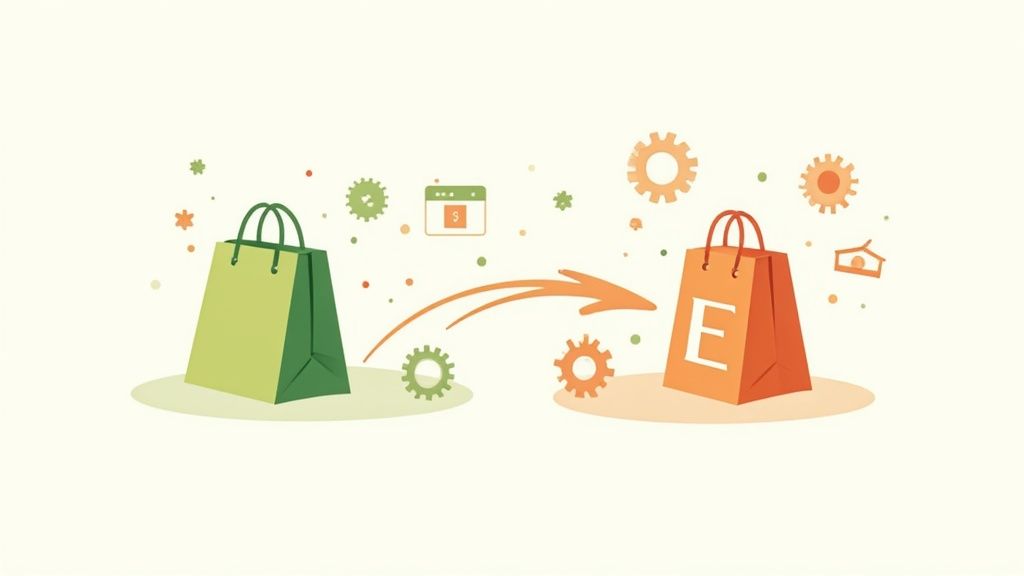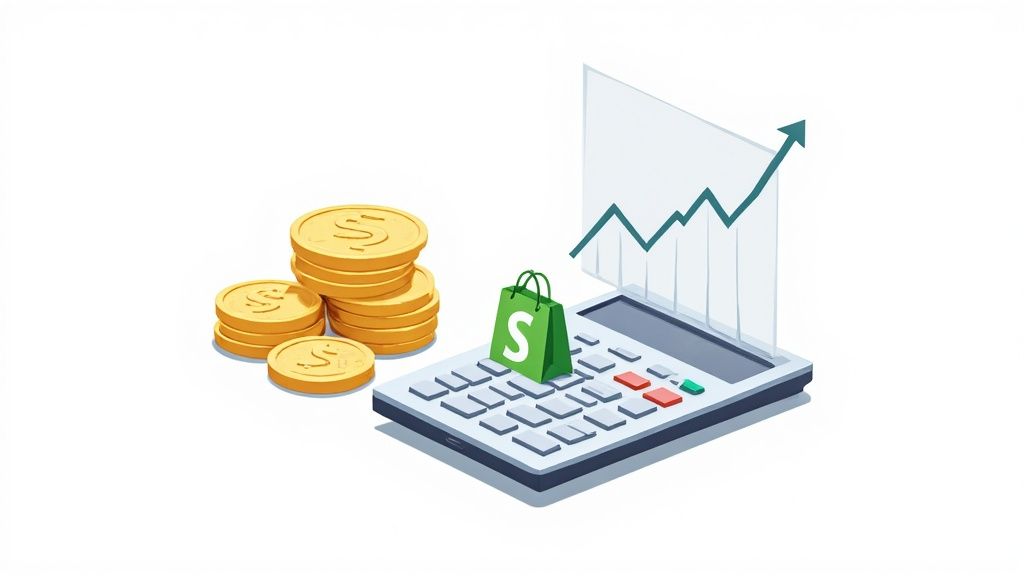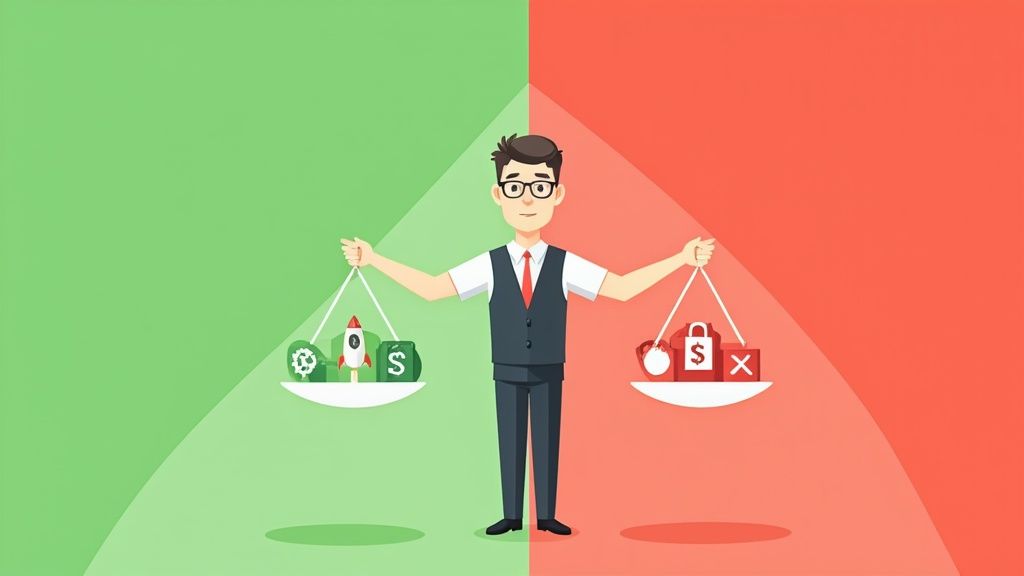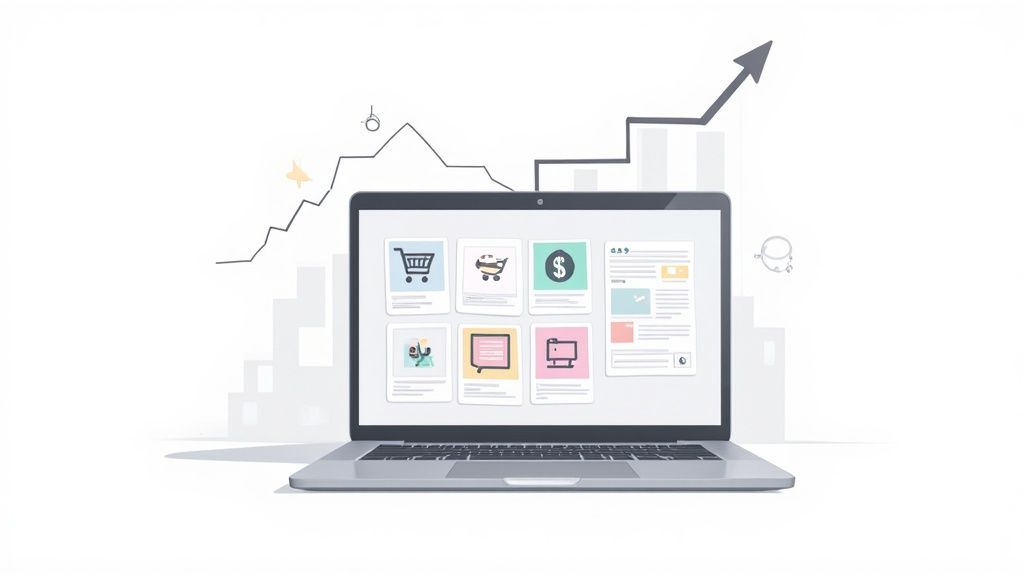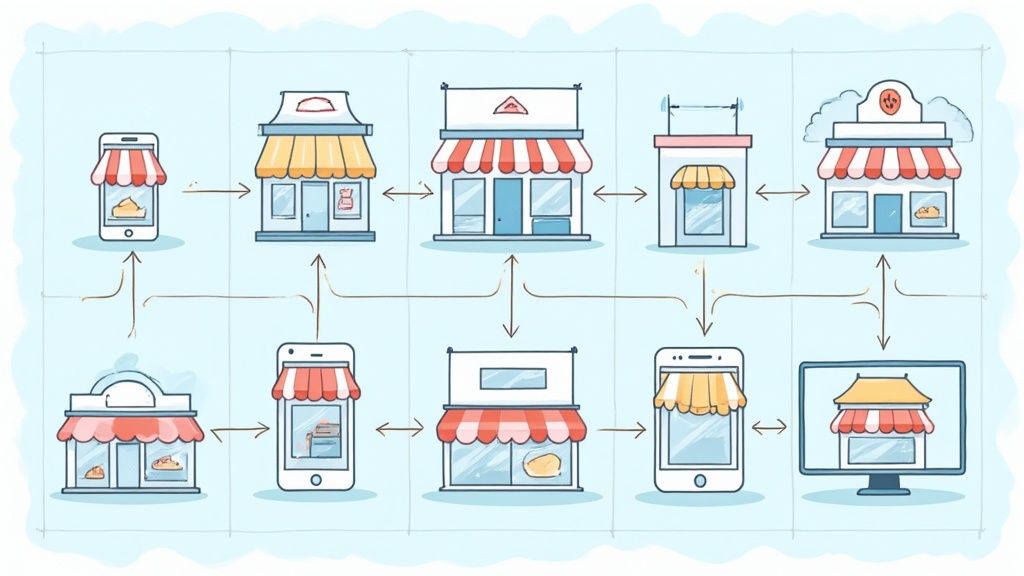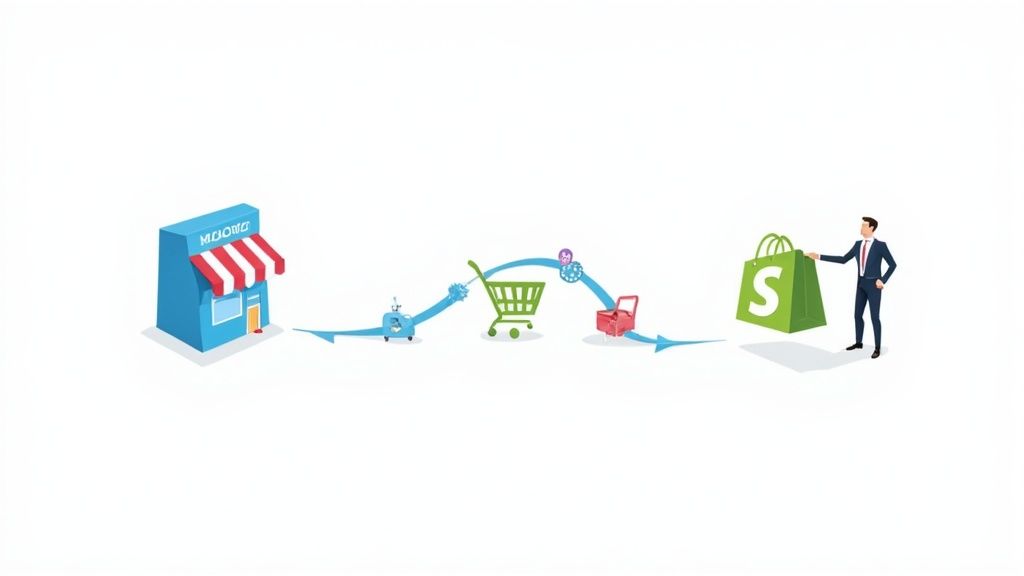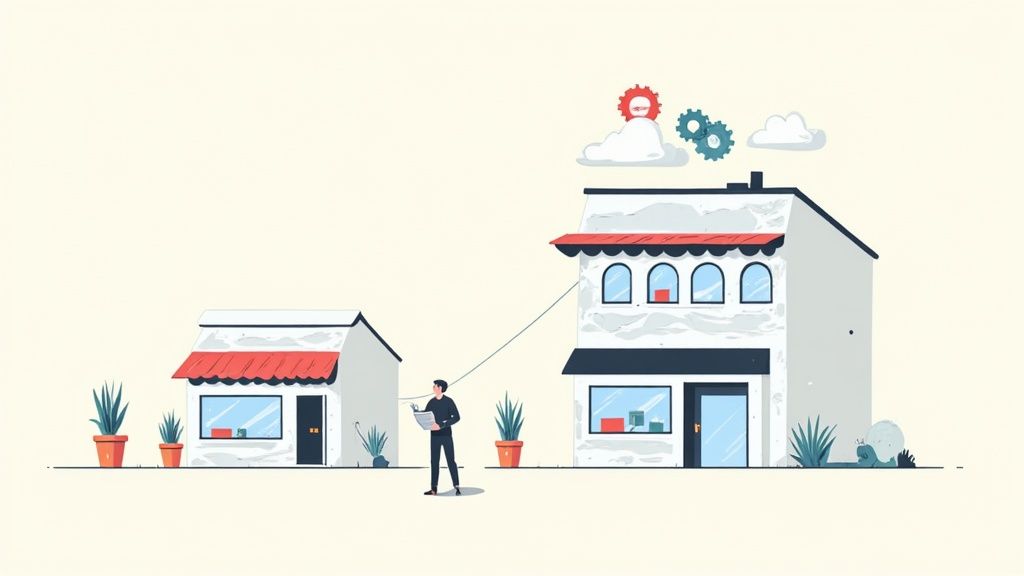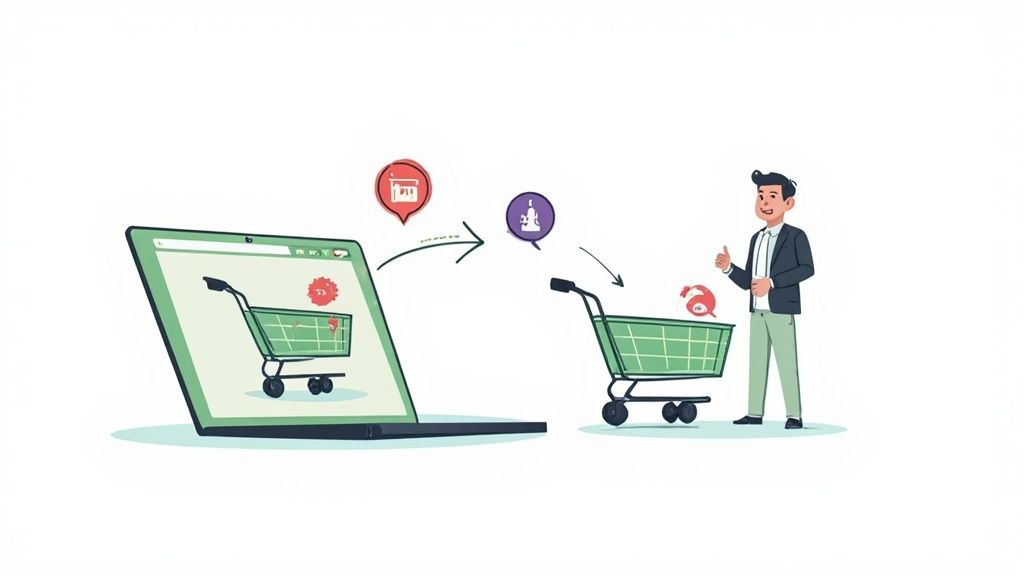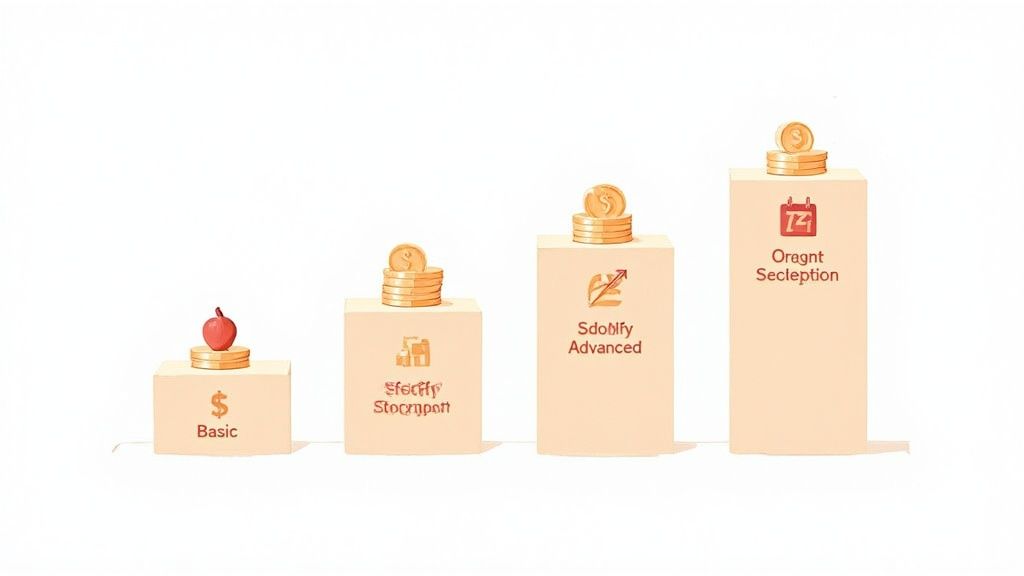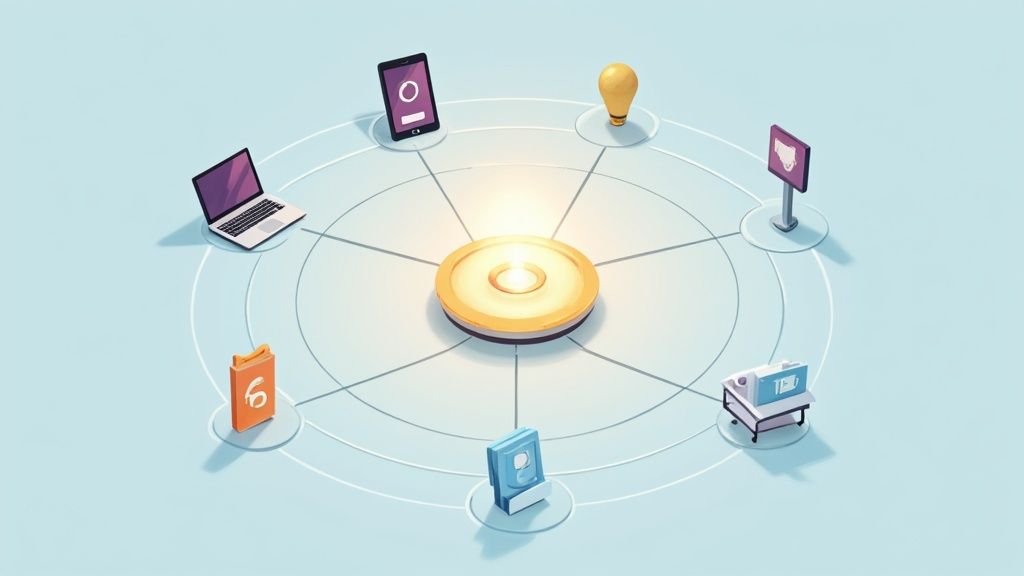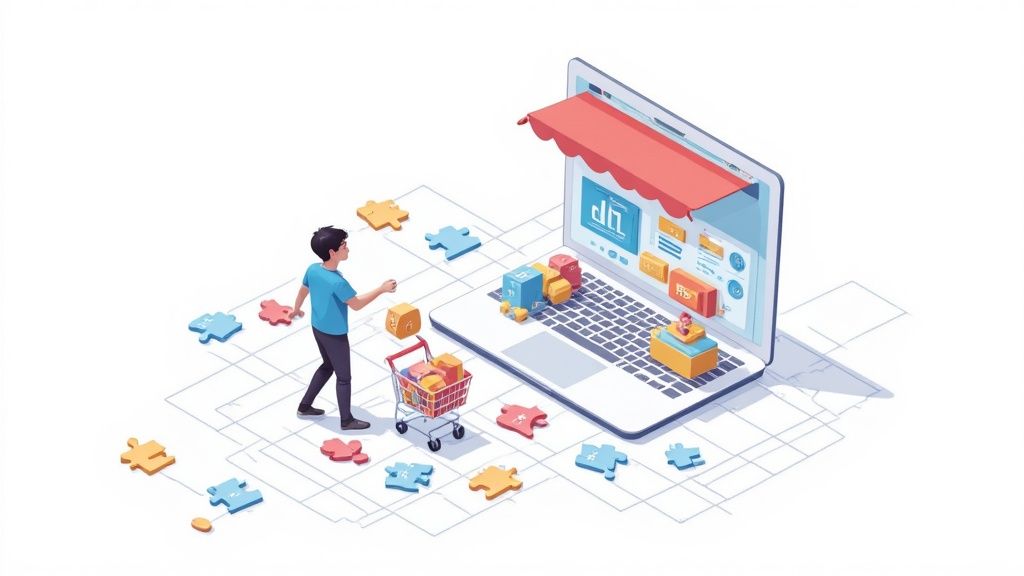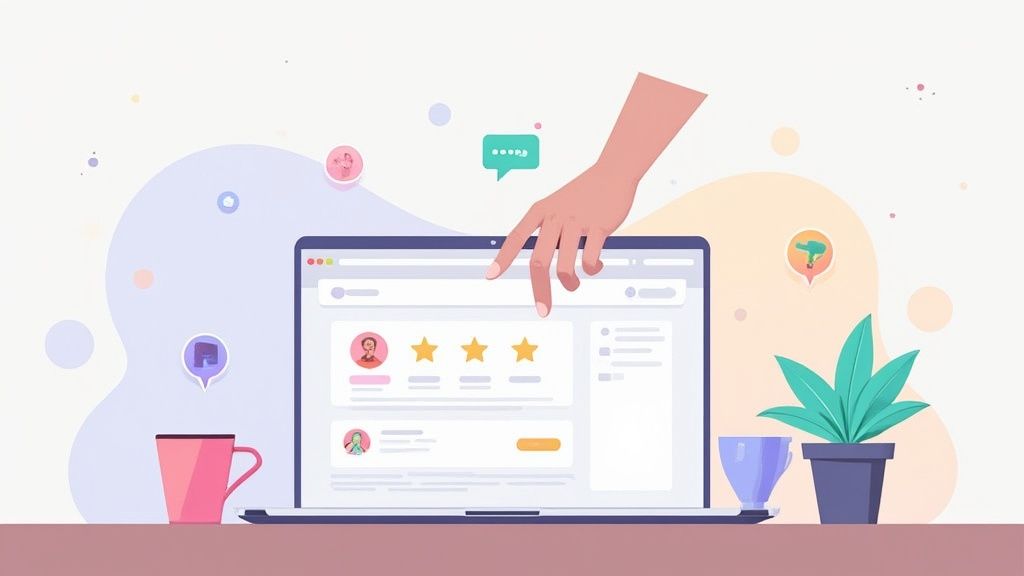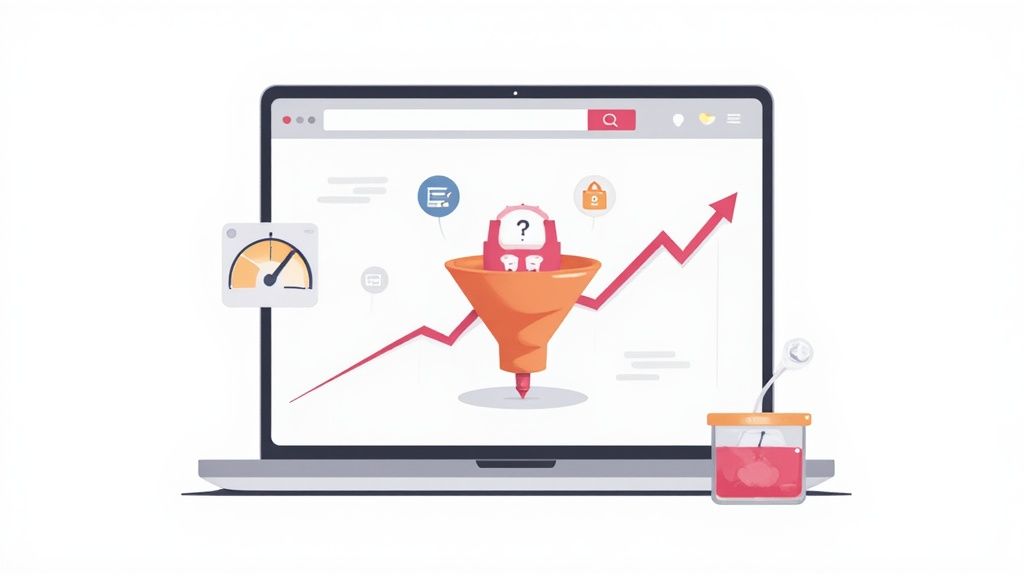
To write a product description that actually sells, you have to stop thinking about your product.
Seriously. You need to stop listing features and start telling a story about the benefits. The real secret is getting inside your customer's head, understanding their problems and dreams, and then showing them—using vivid, sensory language—exactly how your product makes their life better.
Why Most Product Descriptions Fall Flat
Let's be honest, most product descriptions are just… there. They read like a technical manual—a dry, sterile list of specifications, dimensions, and materials. That info is useful, sure, but it almost never convinces someone to click "buy."
The biggest reason they fail is because they ignore the single most important part of any sale: emotion.
They talk at the customer, not to them. They describe the item, but they completely fail to sell the experience.
The Gap Between Features and Feelings
One of the most common mistakes I see is assuming customers will automatically connect the dots between a feature and how it benefits them. Most of the time, they won't bother. It’s your job to build that bridge.
For instance, a backpack's "water-resistant nylon fabric" is a feature. The feeling? That's the peace of mind you get knowing your laptop is safe when you're caught in a sudden downpour.
That feeling is what drives the sale.
Your product isn’t just an object; it’s a solution, an upgrade, a feeling. Great descriptions sell the transformation, not just the tool that gets them there.
When you nail that emotional connection, you build trust. You help shoppers see the product in their own lives. It’s what turns a passive browser into a confident, excited buyer. Once you grasp this, writing descriptions stops being a chore and becomes your most powerful sales tool.
The High Stakes of Getting It Right
There's a reason companies are pouring more money into great copy. The global content writing services market is expected to jump from $19.9 billion in 2023 to nearly $38.6 billion by 2033. That’s a huge signal that businesses see content as a critical driver for sales. You can dive into the full analysis of the content writing market to see just how big this trend is.
When your copy connects, it does more than just close one sale. It hits several key business goals at once:
- It cuts down on buyer hesitation. A great description answers those nagging questions and eases anxieties before they even surface.
- It builds real brand loyalty. This is where you establish a voice that feels authentic and makes people want to stick around.
- It boosts conversions. By directly addressing customer pain points with clear benefits, you give them a powerful reason to buy now.
At the end of the day, a powerful description doesn't just explain what a product is—it communicates why it matters.
Mastering Your Pre-Writing Strategy
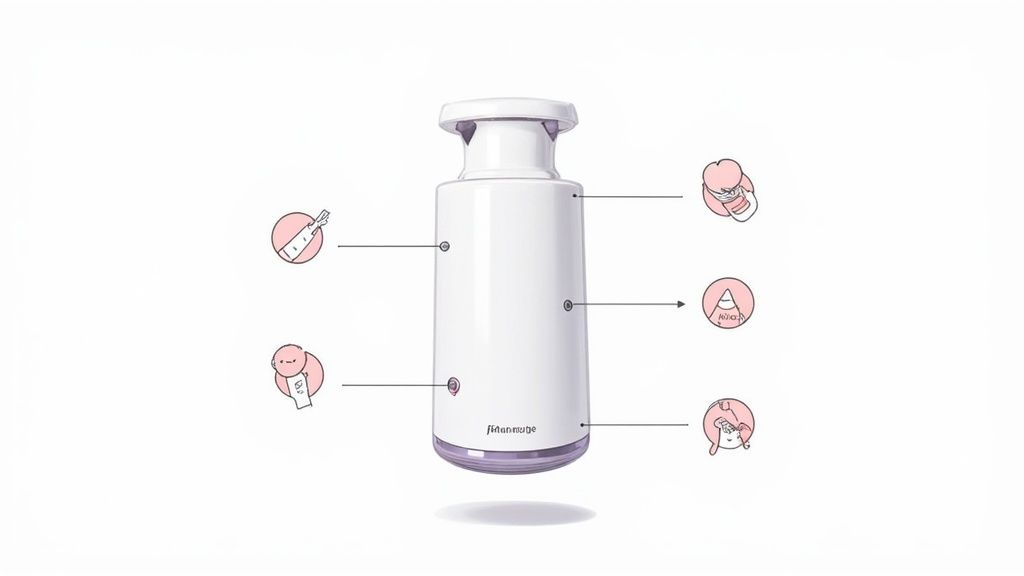
Killer product descriptions don't just appear out of thin air. They're built on a solid foundation of research and strategy before you ever write a single word. The best copywriters I know spend most of their time understanding exactly who they’re talking to and what makes their product the only real choice.
This prep work is the secret sauce. It’s what separates a generic, forgettable description from one that truly connects with a shopper and convinces them to click "add to cart." It’s time to stop guessing and start digging into real data.
Build Your Ideal Customer Profile
You have to know your audience inside and out. A critical first step is diving into effective customer segmentation strategies to get a clear picture of who you're selling to. This goes way beyond basic demographics like age or where they live.
Your mission is to create a buyer persona so detailed it feels like you're writing for a real person. To do this, you need to put on your detective hat and find out where your customers hang out online.
- Dig through customer reviews. Check yours and your competitors'. What specific words do they use to describe their problems? Which features do they rave about?
- Sift through support tickets and survey feedback. These are absolute goldmines for uncovering common frustrations, questions, and what they really want to achieve.
- Eavesdrop on social media and forums. Pay attention to how people talk about products in your niche. What are their raw, unfiltered thoughts?
When you gather this intel, you can pinpoint their exact language, their biggest headaches, and their ultimate goals. This allows you to mirror their own voice back at them in your copy, which builds instant trust.
Translate Features Into Tangible Benefits
Once you know your customer, the next step is connecting your product directly to their world. Here's a hard truth: shoppers don’t buy features; they buy the solutions and feelings those features create. A classic rookie mistake is just listing off tech specs and hoping the customer connects the dots.
You have to do that work for them. My favorite way to do this is with a simple exercise I call the "So What?" test.
- Start with a feature: "Made from 100% merino wool."
- Ask, "So what?": That means it’s incredibly soft and breathable.
- Ask again, "So what?": So it keeps you warm without making you sweat, and it won't feel scratchy against your skin.
- One last time, "So what?": So you can stay comfortable on your hike all day, no matter what the weather throws at you.
That final answer—that feeling of all-day comfort on the trail—is the real benefit. It’s the emotional hook that makes a shopper feel seen and confident about their purchase.
Personalization is a massive force in e-commerce. In fact, research shows that around 80% of consumers are more likely to buy from brands that offer personalized experiences. Your ability to translate a list of features into benefits that speak directly to a customer's specific needs is a powerful, practical form of that personalization. This groundwork ensures your copy doesn’t just describe a product; it sells a better version of your customer’s life.
Proven Formulas for Persuasive Copy
Once you've done your research, you’re ready to start shaping your features and benefits into a compelling narrative. But you don't have to stare at a blank page. Copywriters have relied on time-tested formulas for decades to structure persuasive arguments, and these frameworks are perfect for building out your product descriptions.
Think of them less as rigid rules and more as reliable recipes. They give you a solid structure, making sure you include all the essential ingredients needed to connect with a customer and guide them toward making a purchase. These formulas help you stop listing facts and start telling a story that actually sells.
The whole point is to use language that sparks the imagination and builds a genuine connection. This image perfectly illustrates how a few powerful words can completely transform a simple description.
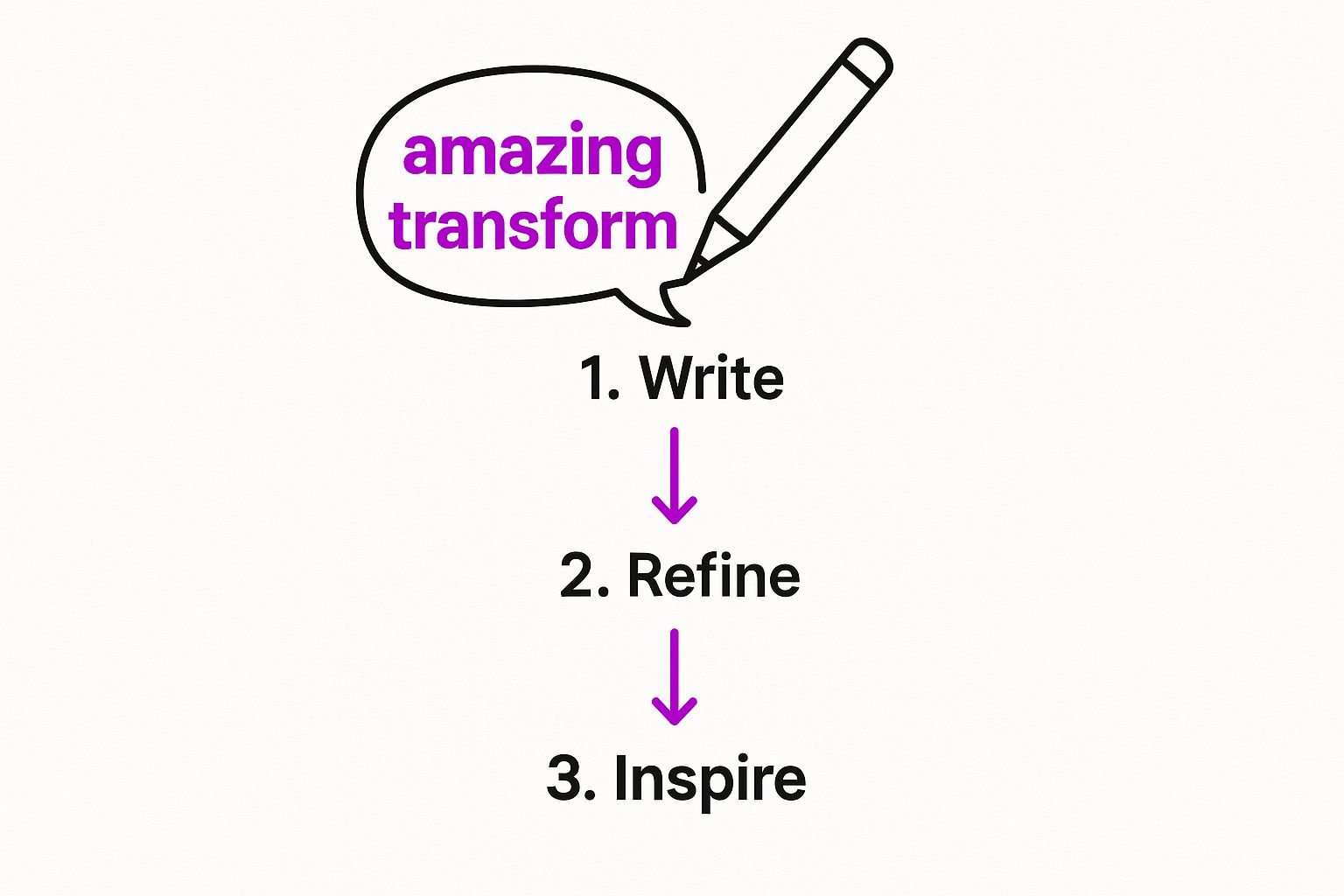
As you can see, the right wording shifts the focus from the product to the feeling the customer gets from it. That's the real key to persuasion.
The AIDA Formula: Attention, Interest, Desire, Action
One of the most classic and effective formulas out there is AIDA. It's a straightforward, four-step process that walks a customer through the psychological journey of deciding to buy something.
Here’s how it breaks down:
- Attention: Grab them immediately. Use a magnetic headline or a bold opening sentence that speaks directly to a core pain point or desire.
- Interest: Now that you have their attention, hold it. Elaborate on the problem or share fascinating details about your product. This is where you introduce it as the perfect solution.
- Desire: This is where you really build the emotional connection. Paint a vivid picture of the benefits and use sensory language to help the shopper imagine themselves using the product and loving the results.
- Action: Finally, tell them what to do next. Use a clear and direct call-to-action (CTA), like "Add to Cart" or "Buy Now," to prompt them to take that final step.
AIDA is so effective because it mirrors the natural decision-making process we all go through when we shop.
The PAS Formula: Problem, Agitate, Solution
Another incredibly powerful formula, especially for products that solve a very specific problem, is PAS. This framework is direct, empathetic, and positions your product as the undeniable hero of the story.
It’s a simple three-step sequence:
- Problem: Start by clearly identifying the customer's pain point. Show them you truly understand what they're struggling with.
- Agitate: Gently poke at that problem. Describe the frustrations, annoyances, and consequences of leaving it unsolved. This creates a sense of urgency.
- Solution: With the need firmly established, introduce your product as the targeted solution. Explain precisely how it resolves their pain and improves their life.
The PAS formula works so well because it taps directly into a core human motivation: the desire to avoid pain. By validating their frustration first and then offering a clear path to relief, you build immediate trust and relevance.
Copywriting Formulas for Product Descriptions
These frameworks are fantastic starting points for structuring your copy. To make it even clearer, here’s a quick comparison of some popular formulas and how you might apply them.
Each formula offers a slightly different angle, so you can choose the one that best fits your product and your audience's mindset. Don't be afraid to mix and match elements to create something that feels just right.
Crafting a Mini-Story
Beyond the classic formulas, one of the most effective ways to write a product description is to simply tell a short story. Humans are wired to connect with narratives. Instead of just rattling off features, you can frame your description around a relatable scenario.
For instance, if you're selling a durable, insulated coffee mug, don't just say "keeps drinks hot for 12 hours."
Tell a story: "Picture this: a frosty Monday morning commute. Your train is delayed, but your coffee is still piping hot, ready to help you conquer the day. That’s the peace of mind our travel mug delivers." This little narrative helps the customer truly envision the product in their own life, making the benefit feel tangible and much more memorable.
These frameworks will give you a fantastic head start. For an even deeper dive, this comprehensive guide to writing product descriptions that drive sales is a great resource. We also share more tips on our blog about how to write product descriptions that genuinely convert. By mastering these formulas, you'll be able to consistently create copy that connects with shoppers and delivers real results.
A great product description doesn't do you any good if shoppers can't find it. This is where SEO comes in, but let's be honest—many writers hear "SEO" and immediately picture copy stuffed with awkward keywords until it sounds like a dial-up modem.
That’s not the goal. The real trick is to find that perfect sweet spot where you satisfy the search algorithms and still connect with a human being.
Learning how to write a product description that actually ranks starts with getting inside your customer's head. You have to think like they do. Instead of just guessing what they're typing into Google, a little bit of keyword research will give you a massive advantage.
Finding the Right Keywords
First things first, grab a notepad (digital or otherwise) and brainstorm all the different ways someone might search for your product. Go beyond the obvious.
Let’s say you’re selling a pair of hiking boots. Your keyword list might start to look something like this:
- Primary Keyword: "men's waterproof hiking boots" (The main event)
- Secondary Keyword: "lightweight trekking shoes" (A related, but different phrase)
- Long-Tail Keyword: "best hiking boots for rocky trails" (Super specific)
Honestly, these long-tail keywords are where the magic happens. They are so specific that the person searching is usually much closer to making a purchase. Someone looking for boots for "rocky trails" isn't just browsing; they have a problem and are actively looking for the solution. Capturing that traffic is a fast track to better conversion rates.
You can use free tools like Google's Keyword Planner or paid options to see what phrases people are actually using and which ones you have a realistic shot at ranking for.
The secret to good SEO isn't about fixating on one perfect keyword. It’s about building a small, relevant cluster of phrases that covers how different people search for the same thing.
Once you've got your list, you can start weaving these terms into your product page. The key is to make it feel completely natural, not like you're checking boxes off a list.
Weaving Keywords into Your Page
Strategic placement is everything. You need to send clear signals to search engines about what your page is about, but without sacrificing the flow and readability for your human visitors.
Here’s a quick rundown of the most important places to put your keywords.
1. Your Product Title (H1)
This is the big one. It's the first thing both users and Google see. Your primary keyword should be right here. For instance, "Summit Pro Waterproof Hiking Boots for Men" is worlds better than just "Summit Pro Boots."
2. Subheadings (H2, H3)
Drop your secondary and long-tail keywords into your subheadings. A subheading like "Built for All-Weather Trekking" instantly tells users and search engines about a key benefit while naturally including a keyword.
3. Body Copy
Sprinkle your keywords throughout the main description. A good rule of thumb is to use your main keyword once within the first 100 words, and then add it in a few more times only where it sounds right. If you're not sure, read it out loud. If it sounds clunky, it is.
4. Image Alt Text
This is a constantly overlooked goldmine for SEO. The alt text should briefly describe the image for visually impaired users and search engines. For a picture of the boots in action, you could write: "Man wearing Summit Pro waterproof hiking boots on a rocky path." It's descriptive, helpful, and includes a keyword.
The Importance of Unique Content
Finally, and this is non-negotiable: never, ever just copy and paste the manufacturer’s description.
Search engines hate duplicate content. If your description is the exact same as ten other online stores, your chances of ranking well plummet. Writing unique copy for every single product is essential. It tells Google your page offers something different, and more importantly, it gives you the chance to speak directly to your customers in your brand's voice.
Learning from Real-World Examples
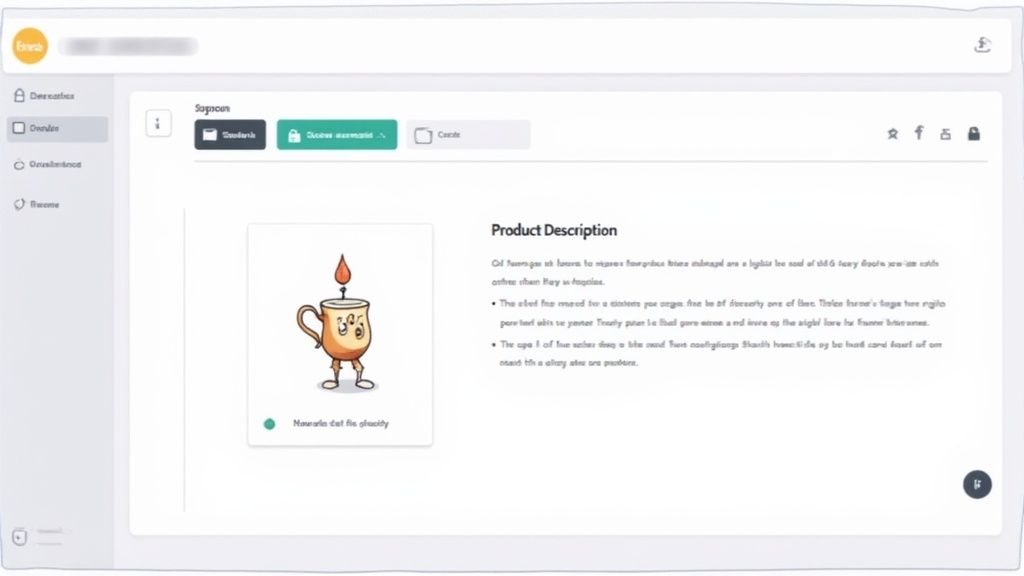
Theory is great, but the real magic happens when you see these principles working in the wild. Let's move from frameworks to the real world and break down what separates a product description that actually sells from one that just sits there. By looking at examples from different industries, you'll start to see the patterns that work and, just as importantly, the common mistakes to sidestep.
Think of this as a hands-on teardown. We're going to figure out why some descriptions make you want to click "buy now" while others read like a boring instruction manual. The goal is to see exactly how benefit-focused language, smart formatting, and a real understanding of the customer come together to create something truly persuasive.
The Good: An Effective Tech Description
Let's start with something tricky: a high-end portable speaker. The best descriptions for tech products never just list the specs; they sell an entire experience.
Here’s a Winning Example:
"Bring the festival to your backyard. Our portable speaker delivers deep, immersive bass you can feel, turning any gathering into an unforgettable party. With a 24-hour battery life, the music doesn't stop until you do. Plus, its rugged, waterproof design means a little rain—or a spilled drink—won’t end the fun."
This works because it's all about the customer.
- It paints a picture: You can immediately imagine using it ("Bring the festival to your backyard").
- It uses sensory language: Words like "...bass you can feel" create a tangible sense of the product's power.
- It addresses potential worries: The "rugged, waterproof design" line is a direct answer to the customer's fear of breaking an expensive new toy.
Instead of getting bogged down in "lithium-ion battery specs" or the "IPX7 rating," this copy translates those features into real-world benefits: longer parties and zero stress.
The Bad: Where It Goes Wrong
Now, let's look at a weak description for that same speaker. This is the kind of copy that leans on jargon and makes the reader do all the heavy lifting.
Here’s a Failing Example:
"This speaker features dual passive radiators and a high-excursion transducer. It has an IPX7 rating and a 6,000mAh battery. The unit measures 213 x 87 x 88.5 mm and weighs 800g. Connectivity is via Bluetooth 5.1."
This isn't selling; it's just listing specs. It completely fails to answer the customer’s most important question: "How will this make my life better?"
This description is just cold and lazy. It assumes the customer knows what a "high-excursion transducer" is and why they should even care. By focusing only on the technical guts of the product, it misses the entire emotional reason someone makes a purchase. Learning to write a killer product description means always building that bridge from the feature to the feeling.
The first example sells the fun, the freedom, and the experience. The second one sells a list of parts. The difference in conversion potential here is massive. As you write, constantly ask yourself: am I just describing the product, or am I selling the outcome?
Answering Your Top Product Description Questions
Even with the best formulas and strategies, you’re going to hit a few snags. Specific questions always pop up right when you're in the middle of writing. Getting clear, direct answers can help you push through those moments without losing your flow.
Here are the most common questions I get asked—and my straight-up answers.
How Long Should a Product Description Be?
There's no magic number here, but a good rule of thumb is to aim for somewhere between 100-300 words. The real answer, though? It depends entirely on your product's complexity and price.
For something simple like a graphic tee, a short, punchy description with a few key bullet points is all you need. But if you're selling a professional-grade camera, that description needs to work a lot harder. You'll need more detail to answer every single question a potential buyer might have, building their confidence to justify the big investment.
The goal is always persuasion, not word count. Be as long as you need to be to make a compelling case, but as short as possible to keep your reader hooked.
Is Using AI for Product Descriptions Okay?
Absolutely, but you need to be smart about it. AI tools are fantastic assistants. Use them to bust through writer's block, generate a first draft, or even create a few different versions for A/B testing. It can seriously speed up the initial writing process.
However, you should never just copy and paste raw AI content onto your site. Your job is to come in after the AI and act as the expert editor. Fact-check everything, inject your unique brand voice, and weave in the kind of customer insights and emotional nuance that a machine just can't replicate. Use AI for speed, but always rely on your own expertise to make that final connection.
How Often Should Descriptions Be Updated?
You don't need to be rewriting everything constantly. The key is to periodically review your descriptions, especially for your best-selling products or items where you've noticed the conversion rate starting to dip. A great description is a massive lever for success, which is just one of many ways to boost your e-commerce sales.
Here are a few good triggers for an update:
- You've changed the product's features or materials.
- You've received new customer reviews that provide killer social proof you can work into the copy.
- You're launching a new marketing campaign and want to test out fresh messaging.
Ready to transform your product pages into high-converting assets? At ECORN, we specialize in Shopify development and conversion rate optimization to help your brand scale. Discover our flexible solutions today!







